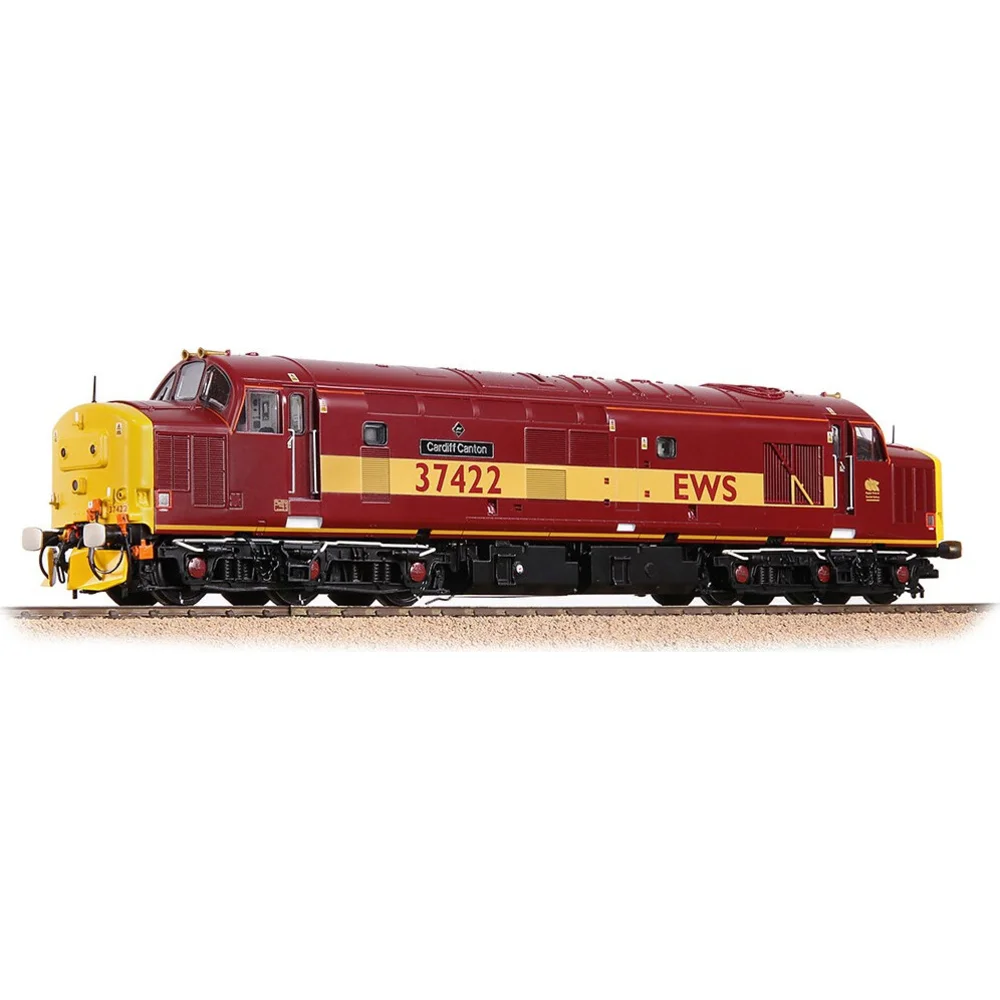Bachmann 35-335K
British Rail Class 37/4 37422 "Cardiff Canton" English, Welsh & Scottish Railway Maroon & Gold
Bachmann's Description & Specifications
Announced during the launch of the all-new Bachmann Branchline Class 37 Diesel Locomotive at the 2022 DEMU Showcase event, we are delighted to present the stunning Class 37/4 No. 37422 ‘Cardiff Canton’ in EWS livery.
The British Rail Class 37 is a favourite among enthusiasts and modellers alike, and this iconic loco returns to the Bachmann Branchline range for 2022, but not as you know it. Following in the footsteps of the award-winning Bachmann Branchline Class 47, our all-new OO scale Class 37 has been designed from the rails up to ensure this classic locomotive is modelled more accurately than ever before, whilst the technical specification is equally impressive and incorporates the same great features as the Branchline Class 47. With high fidelity mouldings, numerous separately fitted parts and countless tooling variations to capture the minutiae of the real locomotives throughout their lives, our new 37 is brought to life with an exquisite livery application using true-to-prototype colours, fonts and logos. Along with an unprecedented array of lighting features, our Dual Fitted speaker system is fitted to all models – bringing to life our SOUND FITTED models. For the ultimate experience, choose one of our award-winning SOUND FITTED DELUXE models with their motorised radiator fan and authentic tinted windscreen glazing!
- Bachmann Branchline OO Scale
- Era 9
- Pristine EWS livery
- Named ‘Cardiff Canton’
- Running No. 37422
- Etched Nameplates included
- Equipped with a Plux22 DCC Decoder Socket - recommended Decoder item No. 36-570A
- Length 245mm
DETAIL VARIATIONS SPECIFIC TO THIS MODEL
- Central Headcode Panels - Plated and fitted with Sealed Beam Marker Lights
- Top Centre Lamp Bracket
- NRN Aerial
- High Intensity Headlight
- Bufferbeam Valance Removed
- Coupling Bash Plate
- Squared Buffers
- Original Windscreen
- English Electric Cantrail Grilles
- Welded Boiler Roof
- Plated Boiler Port and Safety Valves
- Sealed Water Filler Door and Plated Access Steps
- Fabricated Bogies
- Slow Speed Control
- Twin Fuel Tanks with one Gauge per Tank (left hand tank each side)
- Electronic Fuel Gauge
Class & Prototype
- Class: British Rail Class 37/4
- Traction: Diesel
- Transmission: Electric
- Built: 1985-1986
- Total Built: -
The British Rail Class 37 is one of Britain's most successful diesel locomotive designs, with 309 locomotives built 1960-1965 by English Electric. Powered by the proven 12CSVT diesel engine producing 1,750 bhp, these Co-Co diesels served for 65 years on freight, passenger, and mixed-traffic duties across the entire BR network. Known as "Tractors" for their distinctive exhaust note, Class 37s worked everything from East Anglian expresses to West Highland Line services, Welsh coal trains, and nuclear flask operations. Extensive 1980s refurbishment created specialist subclasses including 37/4 ETH passenger variants, 37/5 freight, 37/7 heavy freight, and 37/6 Nightstar variants. Approximately 60 remain in mainline service with 30 preserved. Comprehensive OO gauge models available from Bachmann, Accurascale, and Hornby; N gauge from Graham Farish; O gauge from Heljan across extensive livery ranges spanning BR green through privatisation eras.
No prototype found.
Operator & Livery
- Operator: English, Welsh & Scottish Railway
- Livery: Maroon & Gold
The English, Welsh & Scottish Railway (EWS) operated Britain's largest rail freight network from 1996-2007, controlling 90% of the UK freight market. Formed by Wisconsin Central through acquisition of five British Rail freight companies, EWS revolutionised British freight transport with 250 new General Motors Class 66 locomotives and distinctive maroon and gold livery featuring the famous "three beasties" logo. The company was acquired by Deutsche Bahn in 2007, eventually becoming today's DB Cargo UK while maintaining its freight market dominance.
The EWS maroon and gold livery was introduced in April 1996, with the first locomotive to receive the scheme being Class 37 number 37057, which emerged from Toton Depot on 25 April 1996 to coincide with the launch of the English, Welsh & Scottish brand. The colour specification featured maroon bodysides, roofs and ends with black underframes and buffer beams, standard UK yellow warning panels, and a distinctive gold stripe running centrally between the cab ends.
To ensure accurate colour consistency, a sample plate was flown from Wisconsin Central's American operations to Britain, where British paints were mixed to match this standard. Interestingly, when Class 66 and 67 locomotives were later built by General Motors, another sample plate was sent to the manufacturer, resulting in a slightly lighter shade than the original British mix.
The livery evolved through several variations. Early applications from April 1996 featured "EW&S" lettering (including the ampersand) in Arial typeface within the gold band. From January 1997, this was simplified to "EWS" with improved Gill Sans typeface - continuing a tradition established by the LNER in the 1920s and used by British Railways until the 1960s.
The gold band width varied by locomotive class - most received 600mm bands, but Classes 37, 58, and 73 looked better with 550mm bands due to their distinctive body shapes. Company lettering and locomotive numbers appeared in maroon within the gold stripe with 20mm clearance from the band edges, positioned at opposite ends on each side of the locomotive.
For model railway enthusiasts, specialist paint manufacturers like Phoenix Paints produce authentic colour matches, with their E.W.&S. Red (P193) and E.W.&S. Gold (P194) paints matched to original Wisconsin Central colour panels. Alternative options include RailMatch EWS Maroon (1255) which many modellers prefer for value and colour accuracy.
The EWS maroon and gold scheme became one of the most recognisable railway liveries in modern British history, remaining in use until Deutsche Bahn's acquisition in 2007 and the subsequent adoption of DB Schenker corporate red livery from 2009.
